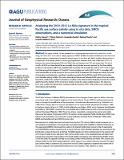Por favor, use este identificador para citar o enlazar a este item:
http://hdl.handle.net/10261/103195COMPARTIR / EXPORTAR:
 SHARE SHARE
 CORE
BASE CORE
BASE
|
|
| Visualizar otros formatos: MARC | Dublin Core | RDF | ORE | MODS | METS | DIDL | DATACITE | |

| Título: | Analyzing the 2010-2011 La Niña signature in the tropical Pacific sea surface salinity using in situ data, SMOS observations, and a numerical simulation |
Autor: | Hasson, Audrey; Delcroix, Thierry; Boutin, Jacqueline; Dussin, Raphael; Ballabrera-Poy, Joaquim CSIC ORCID | Fecha de publicación: | jun-2014 | Editor: | American Geophysical Union | Citación: | Journal of Geophysical Research: Oceans 119(6): 3855-3867 (2014) | Resumen: | The tropical Pacific Ocean remained in a La Niña phase from mid-2010 to mid-2012. In this study, the 2010-2011 near-surface salinity signature of ENSO (El Niño-Southern Oscillation) is described and analyzed using a combination of numerical model output, in situ data, and SMOS satellite salinity products. Comparisons of all salinity products show a good agreement between them, with a RMS error of 0.2-0.3 between the thermosalinograph (TSG) and SMOS data and between the TSG and model data. The last 6 months of 2010 are characterized by an unusually strong tripolar anomaly captured by the three salinity products in the western half of the tropical Pacific. A positive SSS anomaly sits north of 10°S (>0.5), a negative tilted anomaly lies between 10°S and 20°S and a positive one south of 20°S. In 2011, anomalies shift south and amplify up to 0.8, except for the one south of 20°S. Equatorial SSS changes are mainly the result of anomalous zonal advection, resulting in negative anomalies during El Niño (early 2010), and positive ones thereafter during La Niña. The mean seasonal and interannual poleward drift exports those anomalies toward the south in the southern hemisphere, resulting in the aforementioned tripolar anomaly. The vertical salinity flux at the bottom of the mixed layer tends to resist the surface salinity changes. The observed basin-scale La Niña SSS signal is then compared with the historical 1998-1999 La Niña event using both observations and modeling. Key Points The well-marked signature of the 2010-2011 La Nina is described and analyzed In situ, modeled and SMOS surface salinity products show good overall agreement The processes for the western Pacific strong tripolar anomaly shift are studied © 2014. American Geophysical Union. All Rights Reserved | Descripción: | 13 pages, 7 figures, 1 table | Versión del editor: | https://doi.org/10.1002/2013JC009388 | URI: | http://hdl.handle.net/10261/103195 | DOI: | 10.1002/2013JC009388 | Identificadores: | doi: 10.1002/2013JC009388 e-issn: 2169-9291 |
| Aparece en las colecciones: | (ICM) Artículos |
Ficheros en este ítem:
| Fichero | Descripción | Tamaño | Formato | |
|---|---|---|---|---|
| Hasson_et_al_2014.pdf | 2,79 MB | Adobe PDF |  Visualizar/Abrir |
CORE Recommender
SCOPUSTM
Citations
36
checked on 20-abr-2024
WEB OF SCIENCETM
Citations
35
checked on 23-feb-2024
Page view(s)
393
checked on 24-abr-2024
Download(s)
299
checked on 24-abr-2024
Google ScholarTM
Check
Altmetric
Altmetric
NOTA: Los ítems de Digital.CSIC están protegidos por copyright, con todos los derechos reservados, a menos que se indique lo contrario.
